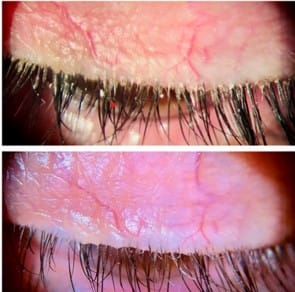February 2, 2024
Every day we see patients and assess their eye health, but where does that assessment actually start? Does it start with their vision, their IOP, the appearance of their fundus? Or does it begin long before we even assess any of those things? Let’s make 2024 the year that you start to assess your patients’ eyelids in a whole new way. If you want to get into aesthetics, this is the gateway. Commit to adding eyelid health as a key piece of your exam for the next 30 days. Why 30 days? Because James Clear, the author of one of my favorite books, Atomic Habits, says that small changes show up in big ways. (Pick up this gem. You’re welcome.) I believe you’ll find that the opportunity to get into aesthetics has been sitting right in front of you. Here are some tips on how to begin.
New Treatment Options Available
Let’s review for a moment the new tools we have. Last year was a huge year for therapeutic drug approvals. We saw Miebo (B&L), VEVYE (Harrow), and XDEMVY (Tarsus) all gain approval. XDEMVY is approved for the treatment of demodex blepharitis, a condition that plagues many of our patients and can even lead to contact lens dropout due to discomfort. It has historically been frustrating to manage, to say the least, because we had no true treatment that killed demodex. What I love about now having a treatment for demodex blepharitis (beyond that it kills demodex, hasta la vista, baby!) is the awareness of eyelid health that comes with it. What I really love about assessing eyelids is how simple it can be. Once you’re behind the slit-lamp, it begins with having your patients look down. What do you notice about Figure 1 below?

Is this how you currently look at lids? Don’t worry, it’s how I did it for years. But what happens when I have the patient look down? See Figure 2 below.

What a difference, right? I can now easily see collarettes (pathognomonic for demodex blepharitis), telangiectasias are much easier to view. Also notice the misdirected and missing lashes. All these signs tell us that something is amiss with eyelid health. How many of your patients complain about their eyelashes being thinner, more brittle, missing? Do you look or ask? This simple change and mindset shift can really be the gateway to your aesthetics clinic. Conquer this conversation and you can apply this to everything you do in the aesthetics realm moving forward. To practice, determine what you see here in Figure 3 below.
This is a patient who has long suffered with dry eye (H16.233), which she in fact does have. I also coded ocular rosacea, demodex blepharitis (B88.0), and meibomian gland dysfunction. I had her continue her immunomodulator BID, and I started her on XDEMVY BID for six weeks. Because it can take some time for our patients to receive the medication from BlinkRx, I like to perform debridement in the office to remove biofilm and all that waxy, waste build up left from our demodex foes. I use the ZEST system from Zocular, and patients walk away immediately feeling better.
I have found that many patients don’t realize how bad their eyelids felt until demodex blepharitis is addressed. I also started her on an intense pulsed light (IPL) series and finished with heat and expression to manage her rosacea and meibomian gland dysfunction, respectively. If we had only addressed this patients’ “dry eye” we would have missed the opportunity to treat/manage her, fully leaving both patient and practitioner underwhelmed with the results. This is a great case example of incorporating what we do as eye care providers and how we can improve patients’ aesthetic appearance as well. Check out some before and after images in Figures 4, 5, and 6.
Figure 4. A patient at four and a half weeks on XDEMVY
Figure 5. A patient at six weeks on XDEMVY
Figure 6. A patient at six weeks on XDEMVY
Awareness, Knowledge, Application, Skill, Habit
One of my favorite tools when I’m learning something new is a simple acronym AKASH. It stands for Awareness, Knowledge, Application, Skill, Habit. Application is always the hardest one to achieve because it requires us to do something different. The first step in aesthetics, specifically eyelids, is awareness, starting to look at your patients differently. Build your knowledge by tuning in here, attending CE, watching tutorials, or listening to podcasts, learning all you can about therapeutic drug approvals. Apply the new techniques you’ve learned, build that skill, and before you know it, that skill will become a habit that you won’t be able to imagine ever doing any other way. Conquer the eyelid conversation by first having your patients look down!









